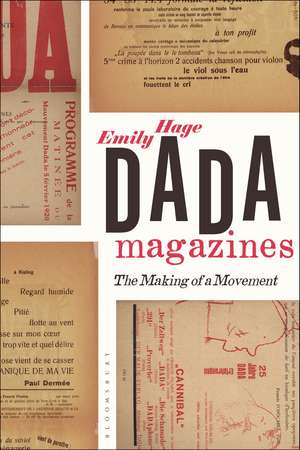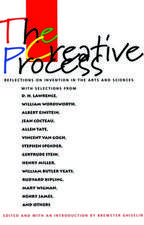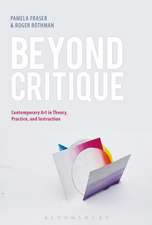Dada Magazines: The Making of a Movement
Autor Dr. Emily Hageen Limba Engleză Paperback – 30 noi 2022
| Toate formatele și edițiile | Preț | Express |
|---|---|---|
| Paperback (1) | 166.61 lei 3-5 săpt. | +42.79 lei 6-12 zile |
| Bloomsbury Publishing – 30 noi 2022 | 166.61 lei 3-5 săpt. | +42.79 lei 6-12 zile |
| Hardback (1) | 514.07 lei 6-8 săpt. | |
| Bloomsbury Publishing – 27 ian 2021 | 514.07 lei 6-8 săpt. |
Preț: 166.61 lei
Preț vechi: 192.89 lei
-14% Nou
Puncte Express: 250
Preț estimativ în valută:
31.88€ • 33.25$ • 26.50£
31.88€ • 33.25$ • 26.50£
Carte disponibilă
Livrare economică 28 februarie-14 martie
Livrare express 13-19 februarie pentru 52.78 lei
Preluare comenzi: 021 569.72.76
Specificații
ISBN-13: 9781350213838
ISBN-10: 1350213837
Pagini: 224
Ilustrații: 10 colour and 58 bw illus
Dimensiuni: 156 x 234 x 21 mm
Greutate: 0.38 kg
Editura: Bloomsbury Publishing
Colecția Bloomsbury Visual Arts
Locul publicării:London, United Kingdom
ISBN-10: 1350213837
Pagini: 224
Ilustrații: 10 colour and 58 bw illus
Dimensiuni: 156 x 234 x 21 mm
Greutate: 0.38 kg
Editura: Bloomsbury Publishing
Colecția Bloomsbury Visual Arts
Locul publicării:London, United Kingdom
Caracteristici
Organized thematically, chronologically, and comparatively, it highlights the momentum of the group and the many exchanges that made Dada so widespread and diverse and charts the major changes in the movement over time that are often overlooked in existing sources, which overwhelmingly assess Dada by city
Notă biografică
Emily Hage is Associate Professor of Art History, Saint Joseph's University, USA.
Cuprins
List of PlatesList of FiguresAcknowledgementsIntroduction 1. An Extraordinary Opportunity to be Denounced as a Wit: How Magazines Launched 'Dada,' 1916-1917 2. 'Every page must explode': Dada Magazines as Exhibition Venues, 1918-19193. Printing Artworks, Exhibiting Ephemera: Dada Journals and Exhibitions, 1920-19214. 'Be on your guard, Madam': New York Dada and the Magazine as Readymade, 19215. Contingency and Continuity: Dada Magazines and the Expanding Network, 1922-1926Epilogue: Magazines to Zines: Echoes of Dada in 1970s AmericaBibliographyIndex
Recenzii
Hage's book offers something different. It provides an introduction, a cohesive narrative, and a path through the movement from a revised perspective in which journals take center stage. ... The outstanding achievement in this book is its ability to look beyond the particulars of these journals . that have long entranced Dada scholars, in the interest of uncovering their role as an underlying system ("langue"), with myriad game-changing implications.
Magazines were the lifeblood of Dada, a movement that still resists neat pigeonholing in the history of the avant-gardes. Emily Hage's Dada Magazines brings a fresh eye to these publications and presents new arguments and evidence for their importance, not just as the print conduits for the manifestos, art, poems, polemics, gossip, and diverse writings of the small, widely separated groups of activists who produced them, under a non-name that spread like a virus, but as active in their own right-creating networks and influencing Dada exhibitions, for example. Hage expertly lays out the ways the juxtapositions, collages, jokes, and confrontations in the magazines influenced radical methods of display in Dada exhibitions and installations. Hage's lucid presentation, focusing on the material production, presence, and impact of the magazines, is especially valuable for the breadth of her research, bringing out the later strands of Dada in unexpected places like Zagreb and Bucharest. This excellent study of the magazines is a timely reminder of the way Dada has remained a cultural, artistic, political, and even moral irritant, whose tactics have been repeated in so many contexts over the last century: from appropriation to performance, parody to the readymade, and are still not quite laid to rest in history, as Hage's fascinating epilogue, looking at the 'Dadazines' of the sixties and seventies, explains.
If we thought that we knew everything there was to know about Dada periodicals, Emily Hage's Dada Magazines sets us right. This engaging and elegantly crafted study provides fresh approaches to the 'active agents' of Dada's formation and spread.
The international dissemination of its creative energy, its anarchic humor and its response to the contradictions of modernity made Dada possibly the most vital of the early twentieth-century avant-gardes. Emily Hage's lively, meticulously researched volume tackles the issue of Dada's geographical expansion head-on, offering the most complete study of Dada magazines, in all their inventiveness and diversity, currently available to scholars.
Magazines were the lifeblood of Dada, a movement that still resists neat pigeonholing in the history of the avant-gardes. Emily Hage's Dada Magazines brings a fresh eye to these publications and presents new arguments and evidence for their importance, not just as the print conduits for the manifestos, art, poems, polemics, gossip, and diverse writings of the small, widely separated groups of activists who produced them, under a non-name that spread like a virus, but as active in their own right-creating networks and influencing Dada exhibitions, for example. Hage expertly lays out the ways the juxtapositions, collages, jokes, and confrontations in the magazines influenced radical methods of display in Dada exhibitions and installations. Hage's lucid presentation, focusing on the material production, presence, and impact of the magazines, is especially valuable for the breadth of her research, bringing out the later strands of Dada in unexpected places like Zagreb and Bucharest. This excellent study of the magazines is a timely reminder of the way Dada has remained a cultural, artistic, political, and even moral irritant, whose tactics have been repeated in so many contexts over the last century: from appropriation to performance, parody to the readymade, and are still not quite laid to rest in history, as Hage's fascinating epilogue, looking at the 'Dadazines' of the sixties and seventies, explains.
If we thought that we knew everything there was to know about Dada periodicals, Emily Hage's Dada Magazines sets us right. This engaging and elegantly crafted study provides fresh approaches to the 'active agents' of Dada's formation and spread.
The international dissemination of its creative energy, its anarchic humor and its response to the contradictions of modernity made Dada possibly the most vital of the early twentieth-century avant-gardes. Emily Hage's lively, meticulously researched volume tackles the issue of Dada's geographical expansion head-on, offering the most complete study of Dada magazines, in all their inventiveness and diversity, currently available to scholars.

























